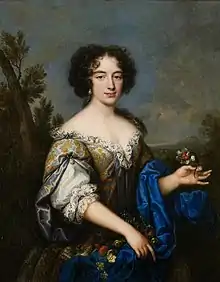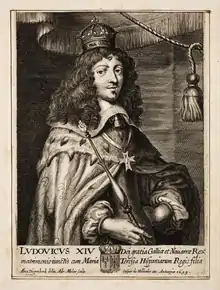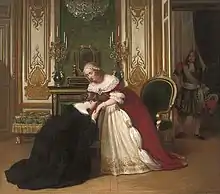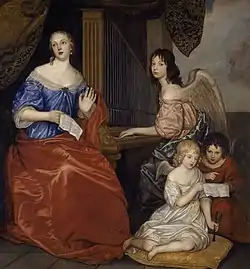Louise de La Vallière | |
|---|---|
 Portrait by Pierre Mignard I | |
| Born | Françoise Louise de La Blaume Le Blanc de La Vallière 6 August 1644 |
| Died | 7 June 1710 (aged 65) Paris, Kingdom of France |
| Burial place | Cemetery of the Carmelite convent in Notre-Dame-des-Champs, Paris |
| Other names | Mademoiselle de La Vallière Sister Louise de la Miséricordie |
| Known for | Mistress of Louis XIV |
| Title | Duchess de La Vallière, Duchess of Vaujours |
| Successor | Marie Anne de Bourbon |
| Children | 5, including Marie Anne de Bourbon Louis, Count of Vermandois |
| Parent(s) | Laurent de La Vallière Françoise Le Prévost |
Françoise Louise de La Vallière, Duchess of La Vallière and Vaujours, born Françoise Louise de La Baume Le Blanc de La Vallière, Mademoiselle de La Vallière (6 August 1644 – 7 June 1710) was a French noblewoman and the first mistress of Louis XIV of France from 1661 to 1667. She was created suo jure Duchess of La Vallière and Duchess of Vaujours. After leaving the royal court, Louise dedicated her life to religion, becoming a nun in 1674.
Ancestry and early life (1644–1661)
Françoise Louise de La Baume Le Blanc de La Vallière, Mademoiselle de La Vallière was born on 6 August 1644 at the Hôtel de la Crouzille (also known as Hôtel de la Vallière) in Tours as the daughter of military officer Laurent de La Baume Le Blanc, Lord of La Vallière and his wife, born Françoise Le Prévost, widow of a councillor of the parlement. The La Blaume Le Blanc family had distinguished itself in military service to the crown, while the Le Prévosts had served the throne with their legal knowledge for generations.[1] At the time of her birth, her father was the governor of the Castle of Amboise, where she spent her first years, alongside her family's Castle of La Vallière in Reugny.[2] During these years, she was educated by her aunts, Ursuline nuns Élisabeth and Charlotte, in reading, grammar, musical composition and public speaking.[1]
Following her father's death, La Vallière's mother married Jacques de Courtavel, Marquess of Saint-Rémy, butler of the exiled Gaston, Duke of Orléans. La Vallière served as a lady's companion to the duke's three younger daughters, Princesses Marguerite Louise, Élisabeth Marguerite, and Françoise Madeleine, being educated with them in painting, music, etiquette, equitation, literature and philosophy by the Duke's first almoner,[3] Armand Jean le Bouthillier de Rancé,[1] who would later found the Trappists order.[3] After the death of the Duke, his widow moved with her daughters to the Luxembourg Palace, Paris and took sixteen-year-old La Vallière with them.
Life at the royal court (1661–1671)
Through the influence of a distant relative, Madame de Choisy, Mademoiselle de La Vallière was named maid of honour to Henrietta, the new Duchess of Orléans, wife of Louis XIV's brother Philippe I, Duke of Orléans. She moved to her home, the Tuileries Palace.[4] Henrietta, known as 'Madame' joined the court at Fontainebleau in 1661, where La Vallière likely first met her future lover, Louis XIV.[4] She served the Duchess together with Françoise de Rochechouart de Mortemart, Mademoiselle de Tonnay-Charente, the future Madame de Montespan.[5]
Louis XIV's mistress (1661–1667)

A close relationship soon formed between the king and Madame, which concerned the Queen Dowager, Anne.[6] To counter rumours, they allegedly decided that he should court other women as a front, for which Madame herself selected three young ladies, including La Vallière. She spent only two months in Fontainebleau before becoming the King's mistress. According to one version of the events, she did not know she was part of a ploy to avert scandal, believing the monarch's feelings to have been sincere. Apart from her skills in various arts and sports, it was La Vallière's innocence and sincerity that captured the King: one source states that he fell in love with her after, upon their first meeting, she exclaimed "Ah! if he was not the King...".[7][8]
This was Mademoiselle de La Vallière's first relationship. She was reportedly an innocent, religious girl who did not behave flirtatiously or act out of self-interest during the romance. She was not extravagant, nor was she interested in wealth or titles. Antonia Fraser writes that she was a 'secret lover not a maîtresse-en-titre like Barbara Villiers'.[9] Nicolas Fouquet's curiosity in the affair was one of the causes of his disgrace: when he bribed Louise, the king mistakenly thought that Fouquet was attempting to make her his lover.[10][clarification needed] The affair, although discreet, quickly became public, angering the clergy, including celebrated orator and future Bishop of Meaux, Jacques-Bénigne Bossuet, as well as many religiously devoted people in the court. It also invoked the bitter sarcasm of Madame. Wishing to avoid scandal and a confrontation with his mother, the King moved La Vallière to a hunting lodge in the forest near Versailles, not far from Saint-Germain-en-Laye.[7]
In February 1662, the couple had a conflict: upon direct questioning by the King, La Vallière refused to tell him about an alleged affair between Madame and Armand de Gramont, Count of Guiche. Around the same time, Bossuet delivered a series of Lenten sermons condemning the immoral activities of the King through the example of David's adultery, which troubled La Vallière's conscience, and she fled to a convent in Chaillot.[11] Meanwhile, her enemies, led by Olympia Mancini conspired for her downfall by informing Queen Maria Theresa of the affair.[12]
During her first pregnancy in 1663, La Vallière was removed from the service of Madame and sent to live in the Palais-Royal, where, on 19 December 1663, she gave birth to a son, Charles (1663–1665). He was taken immediately and secretly to Saint-Leu and entrusted to the care of two servants of Chief Minister Jean-Baptiste Colbert. Despite the attempts of Dr Boucher, who was present at the birth and tried to make the transfer as secret as possible, the story quickly spread through Paris. The public scorn at the Midnight Mass on 24 December was so great that La Vallière escaped from the church.[13]

In 1664, Louis XIV hosted a multi-day performance and party, called Les Plaisirs de l’Île enchantée ('The Pleasures of the Enchanted Island') in the hunting lodge where his mistress lived. During the festivities, Molière presented two new plays, La Princesse d'Élide (The Princess of Elid) Tartuffe, [15][16] with musical arrangements by Jean-Baptiste Lully. The event was officially dedicated to Queen Maria Theresa and Queen Dowager, but La Vallière was the unofficial dedicatee, leading to court gossip.[clarification needed] This only worsened when she received the domain of Carrières-sur-Seine, and started building a castle there, with gardens designed by André Le Nôtre, the royal landscape architect.
In 1665, the king had two affairs besides the one with La Vallière: he was temporarily involved with Bonne de Pons d'Heudicourt whose family quickly removed her from the court,[17] then with the Princess of Monaco, born Catherine Charlotte de Gramont. After the death of his mother in 1666, Louis XIV started to display his affair, which greatly displeased La Vallière publicly. Within a week of the dowager queen's death, La Vallière had to appear at mass next to the queen. Ashamed, she treated Maria Theresa with humility and respect.
The end of the royal affair and later life at the royal court (1666–1669)

Around the time of the death of the Queen Dowager, the former Mademoiselle de Tonnay-Charente, now the Marquise of Montespan returned to the service of Madame which she had left upon her marriage in 1663. Now a lady-in-waiting, she quickly established herself as the reigning beauty of the court.[8] Enamoured, the king sought to take her as his new mistress.[18]
In May 1667, before going on a military campaign to Flanders, the king legitimised his only living child with La Vallière, Marie-Anne (1666–1739). Their three eldest children, Charles (1663–1665), Philippe (1665–1666), and Louis (1665–1666) had already died by this time. Marie-Anne thus became a fille legitimée de France ('legitimised daughter of France'), could use the surname de Bourbon and received the title Mademoiselle de Blois. On the same day, he created his mistress Duchess of La Vallière and Duchess of Vaujours.[7] As a duchess, La Vallière had the right to sit on a taboret in the presence of the queen, a highly prized privilege. However, La Vallière was not impressed, saying that the title resembled a present given to a retiring servant. Affirming this, Louis XIV commented that legitimising their daughter and the gifts to La Vallière 'matched his affection for her for six years.' [19]
When the King left for the campaign, the pregnant La Vallière was ordered to stay at the court. Worrying for the King and maybe jealous, she travelled to the battlefield without permission and threw herself at his feet, sobbing uncontrollably. Infuriated, Louis forced her to return home immediately. Madame de Montespan was the first to denounce her for the scandal. The King made La Vallière share an apartment with Montespan at the Tuileries Palace, as the latter's husband was uncomfortable with his wife's affair. During this time, a devastated La Vallière wrote a poem, titled Sonnet to the King.[20]
Five months after the battlefield scandal, on 2 October 1667, La Vallière gave birth to her fifth and last child, Louis, who would later be legitimised. Hoping to win back the King's heart, La Vallière accepted all the humiliations of her new situation: Montespan demanded that she assist her with her toilette, and the King would often command the two rivals to travel in the carriage of the Queen. Her tactic was unsuccessful: the King did not return to her, nor did he end his other affairs.[7]
In 1669, when their physical relationship had long ended, their son was legitimised, created count of Vermandois, and given the post of admiral of France. As he was only two years old, this ensured the King's control over the navy.[21] Around the same time, at the end of March 1669, Madame de Montespan gave birth to her first child by the King. La Vallière served as the newborn daughter's godmother, and she was named Louise-Françoise after her.
The strain of being forced to live with her former lover and his current mistress took its toll on La Vallière: she lost weight and became increasingly pale and exhausted. In 1670, after a nearly fatal, long illness (which, according to some sources, was the result of a miscarriage[22]), she turned to religion, writing her Réflexions sur la miséricorde de Dieu ('Reflections on the Mercy of God'). She remained at court for two more years, trying to lead an exemplary life in the hope of inspiring others. She admitted that she was not 'dead to her passions [for the King], while I feel them live more strongly than ever in what I love more than myself".[23]
Later life (1671–1710)
Following the advice of Jesuit preacher Louis Bourdaloue, supported by Bossuet and Bernardin Gigault de Bellefond, Marquis de Bellefonds, head of the Maison du Roi, she decided to leave the court and enter the Carmelite convent in the Faubourg Saint-Jacques part of Paris, later known as Notre-Dame-des-Champs. Despite the strict rules of the Carmelites, La Vallière rejected the option of being placed in a more relaxed order.
Madame de Montespan wanted La Vallière to return so that her own affair with the King could remain hidden. He urged the Louis to publicly recognise his daughter with La Vallière as Mademoiselle de Blois. She asked her confidant and governess to her children, Madame Scarron (the future Madame de Maintenon) to detail to La Vallière the suffering she would be exposed to at a Carmelite convent, as well as the court scandal that her decision would provoke. Scarron highlighted that she would eventually be forbidden from wearing her custom-made shoes that allowed her to walk without a limp, as one of her legs was shorter than the other. 'When I shall be suffering at the convent', Louise replied, 'I shall only have to remember what they made me suffer here, and all the pain shall seem light to me'.
As a Carmelite nun (1675–1710)

All of the attempts at dissuading her failed, and in 1674, La Vallière was finally permitted to enter the convent. The day she left she threw herself at the feet of the Queen, begging forgiveness, saying that 'My crimes were public, my repentance must be public, too'.[24] One year later, on 3 June 1675, La Vallière took her perpetual vows under the name Louise de la Miséricorde ('Louise of Mercy'), and accepted the black veil from the queen herself, who kissed and blessed her.[25]
In her absence, the new Duchess of Orléans, born Princess Elizabeth Charlotte 'Liselotte' of the Palatinate, known as Madame Palatine, took care of the education of her son Louis. He died on his first military campaign at the age of sixteen, in 1683, while in exile in Flanders for his involvement with a secret group of young aristocrats practicing "le vice italien", homosexuality.[26] His sister and aunt were greatly affected by his death, while his father did not shed a tear. His mother, in reference to the adultery of his conception, said, 'I ought to weep for his birth far more than [for] his death'.[27]
Queen Maria Theresia, the Duchess of Orléans, Bishop Bossuet, and Marie de Rabutin-Chantal, Marquise de Sévigné all had a habit of visiting Louise at the convent for spiritual consolation and rest. Later in life, Madame de Montespan also went to her for advice on piety.. Louise forgave her and counselled her on the mysteries of divine grace.
Sister Louise de la Miséricordie died on 6 June 1710, at the age of sixty-five, after thirty-six years of religious life, and was buried in the cemetery of her convent. Her titles and possessions were inherited by her only surviving child, Marie-Anne, by then Princess Dowager of Conti.
Physical appearance
Although she was never described as a striking beauty or naturally brilliant, Louise had qualities that attracted attention: she was discreet, modest and had blonde hair and soft blue eyes. She was afflicted with a limp as one of her legs was shorter than the other,[28] but she wore custom-made shoes and managed to be an accomplished and graceful rider and dancer. At the age of seventeen, she reportedly 'had an exquisite complexion, blond hair, blue eyes, a sweet smile . . . [and] an expression [at] once tender and modest'.[29]
Issue

Louise de la Vallière had five children by Louis XIV, two of whom survived infancy:
- Charles de La Baume Le Blanc (19 December 1663 – 15 July 1665), died in infancy and was never legitimised;
- Philippe de La Baume Le Blanc (7 January 1665 – 1666), died in infancy and was never legitimised;
- Louis de La Baume Le Blanc (27 December 1665 – 1666), died in infancy and was never legitimised;
- Marie-Anne de Bourbon, Légitimée de France (2 October 1666 – 3 May 1739); known as Mademoiselle de Blois after her legitimation. She married Louis Armand I, Prince of Conti and had no issue. She inherited the title of Duchess of La Vallière from her mother;
- Louis de Bourbon, Count of Vermandois (2 October 1667 – 18 November 1683); died at the age of sixteen in exile, during his first military campaign, and had no issue.[30][31]
Legacy and appearances in popular culture
- The term lavalier, meaning a jeweled pendant necklace, comes from her name (or possibly from that of Ève Lavallière). In French, a lavallière is a neck tie tied to form a bow at the front of the neck (reminiscent of a pussy bow), which was popular in the 19th century;[7]
- La Vallière's book Réflexions sur la miséricorde de Dieu ("Reflections on the Mercy of God) were printed in 1767, and in again in 1860 as Réflexions, lettres et sermons, by M. P. Clement;
- Letitia Elizabeth Landon's poetical illustration, Louise, Duchess of La Valliere, to an engraving of a painting by Edmund Thomas Parris, was published in 1838.[32]
- Louise de la Vallière by Maria McIntosh (1854) is her earliest known fictionalised portrayal in English;
- She is one of the main characters in Alexandre Dumas's novel The Vicomte de Bragelonne, the second sequel to The Three Musketeers. Dumas makes her the fiancée of the fictional titular character, son of the musketeer Athos. Some editions break the novel up in several books, one of which is titled Louise de la Vallière.
- In 1922, a German silent film titled Louise de Lavallière was made about her life;
- Marcelle Vioux wrote a 1938 novel about her titled Louise de La Valliere;[33]
- Sandra Gulland wrote a historical novel featuring her, titled Mistress of the Sun, published in 2008;
- Karleen Koen's 2011 novel Before Versailles is told from Louise de la Vallière's point of view;
- Joan Sanders published a biography of Louise in 1959 titled La Petite : Louise de la Vallière ("The Little: Louise de la Vallière");
- Louise Françoise le Blanc de la Vallière, the main female character of The Familiar of Zero, was named after her;
- Christina Rossetti's poem Sœur Louise de la Miséricorde is presumed to be about the Duchess of La Vallière.
See also
Footnotes
- 1 2 3 "La Valliere, Louise de | Internet Encyclopedia of Philosophy". Retrieved 25 May 2022.
- ↑ Gustave Braux: Louise de La Vallière – de sa Touraine natale au Carmel de Paris, C.L.D., 1981, p. 17.
- 1 2 Butler, Charles (1814). The Lives of Dom Armand-Jean Le Bouthillier de Rancé, Abbot Regular and Reformer of the Monastery of La Trappe; and of Thomas À Kempis ... With Some Account of the Principal Religious and Military Orders of the Roman Catholic Church. Longman & Company.
- 1 2 Montpensier, Anne-Marie-Louise-Henriette d'Orléans (1627–1693 ; duchesse de) Auteur du texte (1858–1859). Mémoires de Mlle de Montpensier, petite-fille de Henri IV / collationnés sur le manuscrit autographe avec notes biographiques et historiques, par A. Chéruel,...
We had already seen that Mademoiselle de la Vallière was maid of honor to Henrietta of England, who at that time was still living at the Tuileries
{{cite book}}: CS1 maint: multiple names: authors list (link) CS1 maint: numeric names: authors list (link) - ↑ "Princess Henrietta, Madame: A Fairy Tale". Aspects of History. 12 December 2021. Retrieved 25 May 2022.
- ↑ HILLEMAND, P. (1975). A propos de la mort d'Henriette d'Angleterre Madame, Duchesse d'Orléans (PDF) (in French). p. 117.
- 1 2 3 4 5 Calon, Oliver (2017). "Ah! s'il n'était pas le roi – Louise de la Vallière". Les petites phrases qui ont fait la grande histoire. Vuibert. pp. 84–85. ISBN 978-2311-10216-1
- 1 2 Fraser, Antonia, Love and Louis XIV, Anchor Books, 2006, pp. 70–71.
- ↑ ib. Fraser, pp. 83–84.
- ↑ ib. Fraser, pp. 70–75.
- ↑ ib. Fraser, pp. 80–81.
- ↑ Montpensier, Anne-Marie-Louise-Henriette d'Orléans (1627-1693 ; duchesse de) Auteur du texte (1858–1859). Mémoires de Mlle de Montpensier, petite-fille de Henri IV / collationnés sur le manuscrit autographe avec notes biographiques et historiques, par A. Chéruel,...
{{cite book}}: CS1 maint: multiple names: authors list (link) CS1 maint: numeric names: authors list (link) - ↑ Breton, Guy; Histoires d'amour de l'histoire de France IV: Les favorites de Louis XIV, Presses de la Cité, Paris, 1991, p. 115.
- ↑ "Réunion des Musées Nationaux-Grand Palais". www.photo.rmn.fr. Retrieved 25 May 2022.
- ↑ Dance, spectacle, and the body politick, 1250-1750. Jennifer Nevile. Bloomington: Indiana University Press. 2008. ISBN 978-0-253-35153-1. OCLC 180577252.
{{cite book}}: CS1 maint: others (link) - ↑ Fischer-Lichte, Erika (2002). History of European drama and theatre. Library Genesis. London / New York: Routledge. ISBN 978-0-415-18059-7.
- ↑ Buckley, Veronica (2010). The secret wife of Louis XIV: Francoise d'Aubigne, Madame de Maintenon. Picador. ISBN 978-0-312-43005-4. OCLC 587198685.
- ↑ Letter to Madame de Grignan from 29 July 1676, No. 563 in the edition of Mr. Monmerqué, p. 564 online [retrieved 26 July 2018].
- ↑ ib. Fraser, pp. 111–112.
- ↑ Sonnet, quoted in Lair 1881, p. 224.
- ↑ Rowlands, Guy (29 August 2002). The Dynastic State and the Army under Louis XIV. Cambridge University Press. doi:10.1017/cbo9780511496882. ISBN 978-0-521-64124-1.
- ↑ Les enfants cachés du Roi-Soleil in: histoire-et-secrets.com [retrieved 16 November 2016].
- ↑ Huertas 1998, pp. 134–135.
- ↑ Herman, Elizabeth, Sex with Kings, Harper Collins, 2004, p. 222.
- ↑ Saint-Simon: Memoires, Paris, Librairie L. Hachette et Cie, 1864, vol. 5 of 1864 edition, chapter XXIII, pp. 303–304.
- ↑ Louis was later suspected of being the Man in the Iron Mask.
- ↑ ib. Fraser
- ↑ Louis Bertrand: La Vie amoureuse de Louis XIV, Frédérique Patat, 2013, p. 24.
- ↑ Herman, Eleanor, Sex with Kings, Harper Collins, 2004, p. 106.
- ↑ François Bluche: "Dictionnaire du Grand Siècle".
- ↑ Jean-Christian Petitfils: "Louise de la Vallière".
- ↑ Landon, Letitia Elizabeth (1838). "poetical illustration". Fisher's Drawing Room Scrap Book, 1839. Fisher, Son & Co.Landon, Letitia Elizabeth (1838). "picture". Fisher's Drawing Room Scrap Book, 1839. Fisher, Son & Co.
- ↑ Marcelle Vioux: Louise de La Valliere, Fasquelle 1938, 263 p.
References
- Breton, Guy (1991). Histoires d'amour de l'histoire de France IV: Les favorites de Louis XIV. Presses de la Cité.
- Eleanor Herman (17 March 2009). Sex with Kings. HarperCollins. ISBN 978-0-06-175155-4.
- Antonia Fraser (25 June 2010). Love and Louis XIV: The Women in the Life of the Sun King. Doubleday Canada. ISBN 978-0-385-67251-1.
- Chisholm, Hugh, ed. (1911). . Encyclopædia Britannica (11th ed.). Cambridge University Press.
- Mauclair, Fabrice; Maillard, Brigitte (2010). La Justice seigneuriale du duché-prairie de La Vallière (1667-1790) - Thèse doctorante (in French). Université François-Rabelais, Tours.
- John J. Conley (2002). Mademoiselle de la Vallière: The Logic of Mercy in: The Suspicion of virtue : Women Philosophers in Neoclassical France. Ithaca, Cornell University Press. ISBN 978-0-8014-4020-5.
- Catherine Valogne (1964). Louis XIV et Louise de la Vallière à Versailles (in French). Payot, Lausanne.
- Jean-Christian Petitfils (2002). Louise de La Vallière (in French). Perrin, Paris.
- Jean-Christian Petitfils (2002). Louis XIV (in French). Perrin, Paris.
- Historia magazine n°o 459, March 1985 ISSN 1270-0835
- Huertas, Monique de (1998). Louise de la Vallière, De Versailles au Carmel (in French). Pygmalion.
- Jules Lair (1881). Louise de La Vallière et la Jeunesse de Louis XIV (in French). Plon.
- Claude Puzin (2007). Louis de Bourbon ou le Soleil maudit (in French). T. G.
- Simone Bertière (1998). Les Femmes du Roi-Soleil (in French). éditions de Fallois.